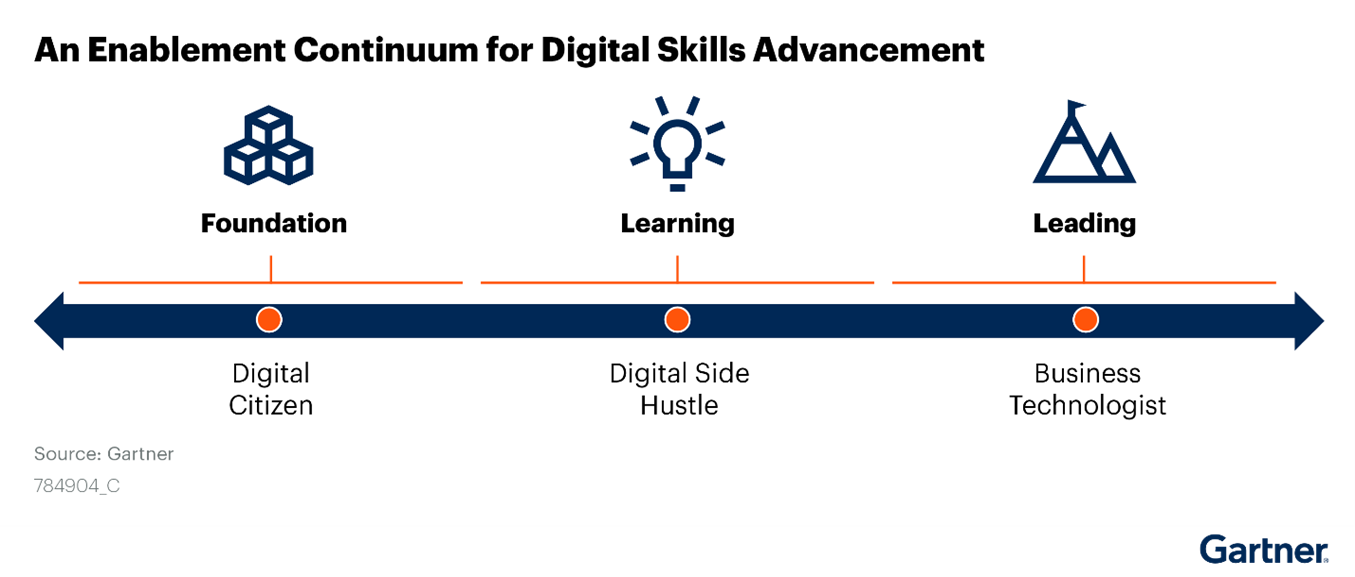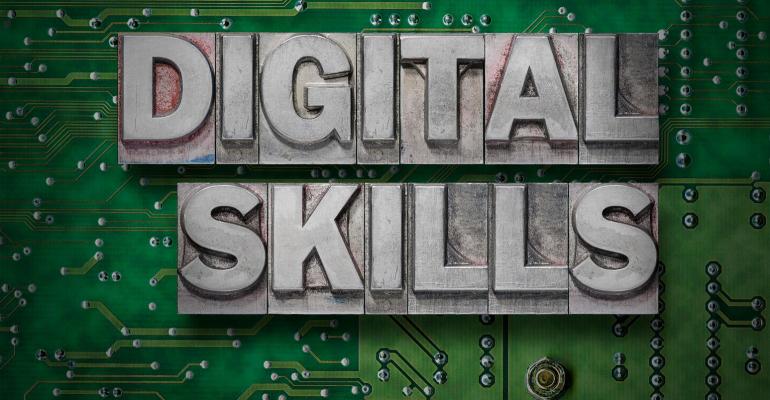Organizations worldwide are experiencing resource constraints and volatility, particularly as the threat of an economic downturn looms. Simultaneously, enterprises face continued pressure to accelerate existing digitization initiatives and launch new ones. As digital demands rise, application leaders responsible for the digital workplace must help employees boost their digital skills — including employees outside the IT function.
Investing in employee digital dexterity has indisputable value. Gartner's Digital Worker Survey for 2023 found that 89% of respondents consider "improvement in digital technology skills" as highly important for career advancement, and 95% of employees cite "improvement in digital technology skills" as critical for work effectiveness. Yet, in many organizations, digital skills development is still treated as a point-in-time activity — fixing a specific need for an employee or small group, but not necessarily addressing a long-term problem.
Organizations must establish modernized digital upskilling methods to retain staff and achieve the next phase of digital transformation. Creating new resources for employees across an enablement continuum can help break down these silos, empowering continuous learning and experiential development opportunities for advancing digital skills.

Establish Foundational Support for Digital Citizens
Digital citizens — employees who use technology regularly to execute work — are representative of the minimum digital aptitude all workers need to complete their job. Employees are using numerous applications to get work done, but the way these tools are being used and employees' baseline proficiency level with them are not well-known or understood.
Creating a "how we work" narrative can help communicate the foundational, intermediate, and advanced skills employees need to support better organizational outcomes with core digital workplace applications. For example, for various tooling categories, such as content creation or meeting solutions, identify:
- When these tools should — and should not — be used
- The foundational, intermediate, and advanced digital skills required for these tools
- Links to relevant resources of communities of practice that can support further learning and development
In most organizations, no one owns the process for identifying the needs of a digital citizen. IT has a unique opportunity to lead the organization through this process to gain maximum advantage from the digital capabilities that employees already have or can learn. IT can then partner with HR to provide upskilling opportunities that are most relevant to employees' careers and desired organizational outcomes.
This may require rethinking the support IT provides for upskilling. For example, consider ways to encourage employees to manage interdependencies across distributed digital initiatives, or to foster security and compliance. IT will also need to supply technologists within and beyond IT with the right tools and platforms for upskilling. Create an employee development action plan template that can be shared with team leaders, which encourages employees to identify specific digital skills they wish to develop and the colleagues who can help.
Upskill Through Digital Side Hustles
Skills are developed through practical application of knowledge. Yet often, the potential for experiential learning is hindered by functional silos, making it difficult for employees to spot development opportunities outside their day-to-day responsibilities.
Digital side hustles are a "gig" tactic whereby employees can develop technical expertise at their own pace through diverse peer and project interactions. Consider employees' responses in their development action plans as a means of strategizing which digital side hustles best suit different technology and digital skill interests. For example, an employee looking to grow their data science skills could serve as a data maven for the enterprise, finding and employing data to inform any business situation. Someone interested in automation could serve as a process hacker, finding repeatable ways to improve work tasks for different teams.
Application leaders responsible for digital workplace collaboration and productivity tools can help the organization establish an enterprise-wide digital side hustle program. While certain departments may create their own digital side hustle programs, the digital workplace leader can serve as the champion for organizational alignment.
Attract Business Technologists with New Ways of Working
In areas where technology activities transcend the capabilities of digital citizens, or where barriers to entry remain too high for short-term digital side hustle learning, organizations are leaning heavily on business technologists. The job of these employees (who report outside of IT) is not to create digital capabilities for others, but rather to build capabilities for performing their own work or that of their teams.
Business technologists may evolve based on employee upskilling, such as identifying a specific need beyond their current skill capabilities and or what self-services tools provide. Or, they may be hired directly by a business manager for a specific purpose, such as automating routine tasks, performing advanced analytics, building or configuring applications, or writing chatbots.
CIOs are turning to these business technologists to accelerate digital business initiatives and boost organizational resiliency. Yet, few companies have sufficient workforce strategies and formal efforts in place to identify, assess, or develop business technologists.
Digital workplace leaders can help close this skill gap by engaging potential business technologists through highly visible digital employee experience projects. Promote the opportunity for these employees to showcase more advanced skills through technology initiatives that impact operating conditions, business practices, or new ways of working.
Based on organizational needs and likely business technologist candidates, consider creating an employee-led center of excellence (COE). This COE can generate significant business value by promoting advanced digital workplace technology usage, such as customizing user interfaces or combining functionalities across disparate collaboration tools. The COE can also act as a networking community, fostering peer-led mentorships between employees with technology interests beyond what the digital side hustle program can provide.
Dynamic learning is the new normal, as business needs and technology evolve constantly. By 2027, organizations that prioritize digital dexterity enablement for both managers and employees will have stronger revenue growth year over year than those that do not. Creating new opportunities for digital upskilling outside of just the IT practice will enable new forms of growth and competitive differentiation.
Joe Mariano is a Director Analyst at Gartner, Inc. who focuses on helping clients establish and maintain their new work hub, including providing enablement and skilling strategies for the digital workplace to help IT leaders and CIOs get the most out of their people and their technology. Joe and other Gartner analysts will provide additional analysis on digital employee experience at Gartner Digital Workplace Summit, taking place June 12-13 in San Diego.





